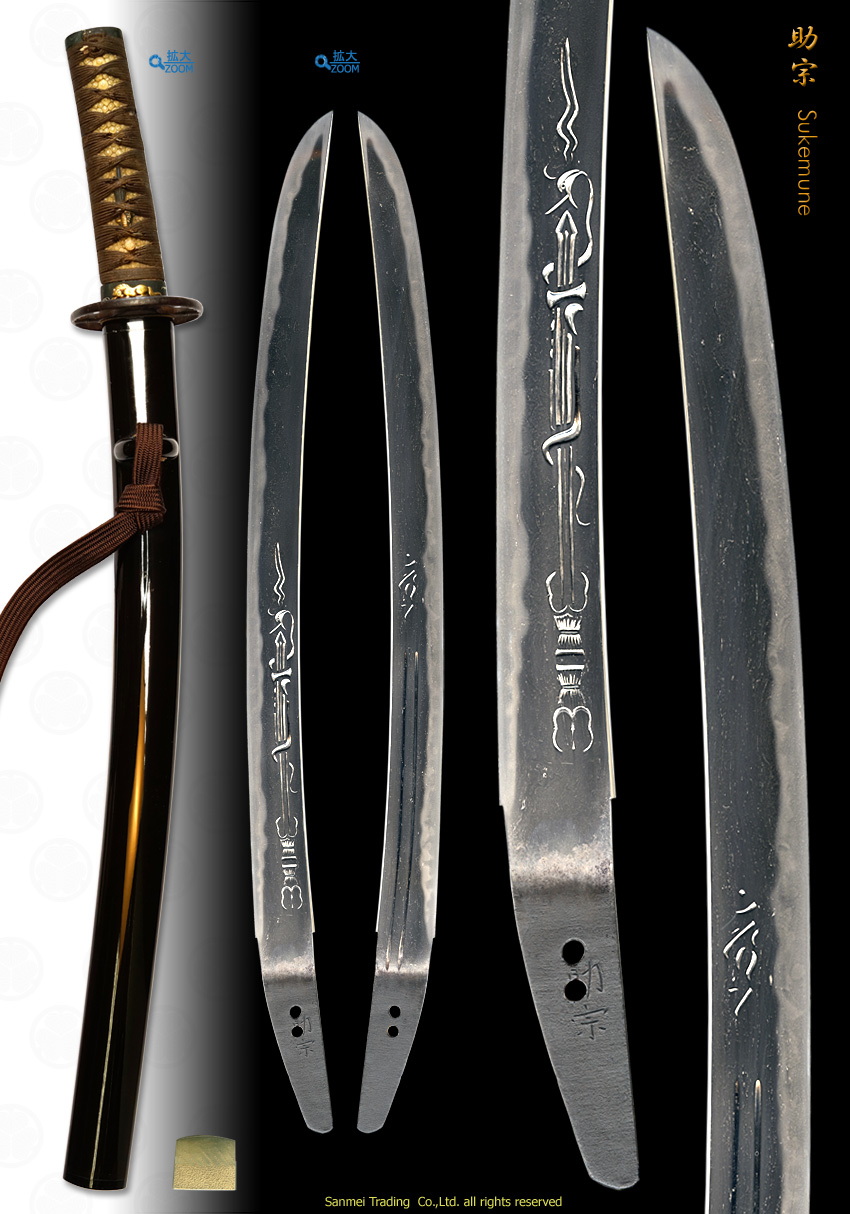with)Black Ro-iro lacquered scabbard Wakizashi Koshirae
Length of cutting edge 42.9cm Curvature 1.2cm Width of Base 31.3mm Thickness of base 5.5mm
Forging (Hada) : Forging is conspicuous Itame wooden grain mark, Masame and flowing Itame ware mostly appear along quench side. Surface is covered in reflecting whitish Ji-nie hard metal granules over the surface along the Mune back side. Darkish Nie lines "Chikei" appears on surface.
Temper line (Hamon) : Hamon is a bit strong side hard metal granule Nie-based, Notare shallow wavy in general, small zigzag (Gunome), of which sparkling foot radiates toward the cutting edge. The interior is covered with mist-like crystallize area "Nioi" where is activated with thick lines of Nie KINSEN and SUNAGASHI areas which corresponds with flowing Masame forging marks.
Temper of tip (Boshi) : Temper of the tip forms irregular line with thick lines of Nie "Hakikake" then sharpen up indication in front, whereas on the other side, becomes medium circle then irregularly turns back deeply.
Tang (Nakago) : Fish belly (Tanago-bara) shape Nakago is UBU, unaltered. Nice taste of patina. Kiri horizontal file marks, there is a little mass on the back ridge. Single-bevelled (Ha-agari Kurijiri) heel in full. Two retaining holes "Mekugiana". There is clear chiselled two large character inscription that reads SUKEMUNE 助宗 under the original peg hole.
Shimada 島田 school in Suruga domain along Ōigawa river, the founder YOSHISUKE 義助 was active in the age of Kousho, middle of 15th century and the other makers such as SUKEMUNE 助宗, HIROSUKE 広助, YOSHITSUNA 義綱, MOTOSUKE 元助 appeared in generations during Muromachi period. Suruga domain in those days, powerful regional warlords of Imagawa 今川, Takeda 武田, Tokugawa 徳川 struggled with each other. Those sword smiths in Shimada school often had made symbolic sign of swords or yaris to meet with requirements from those powerful warlords.
SUKEMUNE 助宗, it's family name Gojo 五条, given name Kyuzaemon 久左衛門 has been said a younger brother of the founder YOSHISUKE 義助 or in other view he moved from province of Bizen to Shimada town in Suruga.
The subject wakizashi is identified the work of SUKEMUNE 助宗 during Tenbun-Eisho era (1532-69) who is highly renowned for the maker of Osoraku-zukuri tanto おそらく造り which was owed by Takeda Shingen 武田信玄. It is unique, extraordinary shape to show the impression that they were strongly influenced by the antient Soushu works of 14th C. Nanbokucho period. Simply style carvings of Kurikara entwined dragon and Gamabash Buddhist implements shows the close resemblance to the ones of Sue-Soushu works.
Fish belly shape of Nakago was popular, frequently seen in Ise-Senko 伊勢千子、Suruga-Shimada 駿河島田、Soushu-Tsunahiro 相州綱広、Bushu-Shitahara 武州下原 schools to understand that frequent cultural exchange became very active along Tōkaidō (region). There is an example of posthumous collaboration Tanto work both by MURAMASA 村正 of Senko school in Ise and SUKEMUNE 助宗 of Shimada school in Suruga.
The entire shape creates a majestic manner of heroic image by powerful warlords to pray for success fervently to the Buddha.
The elaborate made filemarks and chisels of inscription, tang remains excellent taste of patina and to remain an excellent condition over almost 480 yeas history. This wakizashi has been treasured over decades of generations and presenting the typical workmanship of SUKEMUNE 助宗 which was custom made for powerful warlord during the Warning States period. This wakizashi itself is listed in the directory of Tokuno Kazuo, Touko Taikan, Kougei Shuppan, 2001.
Black Ro-iro style lacquered scabbard Wakizashi Koshirae consists of : (click HERE for higher resolution images for each metal fitting)
Fuchi/kashira : a design of horses, Shakudo ground, Takabori carving, gold Iroe inlay unsigned
Menuki : a design of Phoenix, Shakudo ground Yobori carving, gold Iroe inlay
Tsuka/hilt : White rayskin, brown silk cord lozenge wrap which had begun to decay
Tsuba : a design of bamboo/Japanese ginger openwork, Iron ground, Nikubori carving unsigned.
Kozuka : a design of grazing horses, Shakudo ground, Nanako-ji surface Takabori, Iore inlay, gold back panel unsigned.
Seppa : Copper ground/gold plated
Preserved in Shirasaya plain wood mounting, Single layer gold foiled Habaki collar.
Recent polish/Condition scale: excellent-very good (using a scale of mint-excellent-very good-good-fair-poor)
reference data :
Tokuno Kazuo, Touko Taikan, Kougei Shuppan, 2001
Honnma Junji, Sato Kanichi Nihonto Taikan Koto-hen 3, Otsuka Kougeisha, 1969
Honnma Junji, Kanto Hibisho Zoku, Otsuka Kougei sha, 1979
Honnma Kunzan, Ishii Masakuni, Nihonto Meikan, Yuzankaku, 1975

